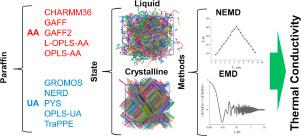当前位置:
X-MOL 学术
›
Int. J. Heat Mass Transf.
›
论文详情
Our official English website, www.x-mol.net, welcomes your
feedback! (Note: you will need to create a separate account there.)
Evaluation of thermal conductivity of organic phase-change materials from equilibrium and non-equilibrium computer simulations: Paraffin as a test case
International Journal of Heat and Mass Transfer ( IF 5.0 ) Pub Date : 2021-02-01 , DOI: 10.1016/j.ijheatmasstransfer.2020.120639 Victor M. Nazarychev , Artyom D. Glova , Igor V. Volgin , Sergey V. Larin , Alexey V. Lyulin , Sergey V. Lyulin , Andrey A. Gurtovenko
International Journal of Heat and Mass Transfer ( IF 5.0 ) Pub Date : 2021-02-01 , DOI: 10.1016/j.ijheatmasstransfer.2020.120639 Victor M. Nazarychev , Artyom D. Glova , Igor V. Volgin , Sergey V. Larin , Alexey V. Lyulin , Sergey V. Lyulin , Andrey A. Gurtovenko

|
Abstract An accurate in silico evaluation of the thermal conductivity is critical for improving the thermal properties of organic phase-change materials on a rational basis. To explore the impact of a theoretical model on the computed thermal conductivity, here we employed the equilibrium and the non-equilibrium molecular dynamics (MD) simulations to study paraffin (n-eicosane) bulk samples, in both crystalline and liquid states, with the use of 10 atomistic force fields, both all-atom and united-atom ones. Overall, we found that the equilibrium MD method is preferable for computing the thermal conductivity of n-eicosane samples (at least for a 10-nm-size simulation box). For the n-eicosane crystals, the all-atom models provide larger thermal conductivity coefficients than their united-atom counterparts and, correspondingly, a better match with the experimental data. This is most likely because the crystalline lattice of the models with explicit hydrogen atoms is additionally stabilized by the electrostatic interactions. In contrast, in the liquid state, most all-atom models overestimate the experimental data for n-eicosane, providing thereby worse performance as compared to the united-atom force fields. However, when it comes to the experimentally observed increase in the thermal conductivity of n-eicosane samples upon crystallization, only all-atom models are able to reproduce quantitatively the experimental data. Each force field of n-eicosane was also characterized by an overall score which accumulated the deviations of the computed thermal conductivity coefficients from the experimental values, for both crystalline and liquid samples. It turns out that the best performance among 10 atomistic models of n-eicosane is observed for the all-atom GAFF force field. All in all, our study clearly demonstrates that a proper choice of the model for computing the thermal conductivity is a non-trivial task: even for such relatively simple compounds as paraffins (n-alkanes), different models perform quite differently, in equilibrium and in non-equilibrium MD simulations, as well as in crystalline and liquid phases.
中文翻译:

从平衡和非平衡计算机模拟评估有机相变材料的热导率:石蜡作为测试案例
摘要 对导热系数进行准确的计算机模拟评估对于在合理的基础上改善有机相变材料的热性能至关重要。为了探索理论模型对计算出的热导率的影响,我们在这里采用平衡和非平衡分子动力学 (MD) 模拟来研究结晶和液态的石蜡(正二十烷)块状样品,其中使用 10 个原子力场,包括全原子力场和联合原子力场。总的来说,我们发现平衡 MD 方法更适合计算正二十烷样品的热导率(至少对于 10 纳米大小的模拟盒)。对于正二十烷晶体,全原子模型提供比联合原子模型更大的热导系数,相应地,与实验数据更吻合。这很可能是因为具有显式氢原子的模型的晶格还通过静电相互作用得到了稳定。相比之下,在液态下,大多数全原子模型高估了正二十烷的实验数据,从而提供了与联合原子力场相比更差的性能。然而,当涉及到实验观察到的正二十烷样品在结晶时的热导率增加时,只有全原子模型能够定量再现实验数据。对于结晶和液体样品,正二十烷的每个力场还以总分为特征,该总分累积计算的导热系数与实验值的偏差。事实证明,对于全原子 GAFF 力场,观察到了 10 个正二十烷原子模型中的最佳性能。总而言之,我们的研究清楚地表明,正确选择用于计算热导率的模型是一项重要任务:即使对于石蜡(正构烷烃)这样相对简单的化合物,不同的模型在平衡和在非平衡 MD 模拟以及结晶和液相中。
更新日期:2021-02-01
中文翻译:

从平衡和非平衡计算机模拟评估有机相变材料的热导率:石蜡作为测试案例
摘要 对导热系数进行准确的计算机模拟评估对于在合理的基础上改善有机相变材料的热性能至关重要。为了探索理论模型对计算出的热导率的影响,我们在这里采用平衡和非平衡分子动力学 (MD) 模拟来研究结晶和液态的石蜡(正二十烷)块状样品,其中使用 10 个原子力场,包括全原子力场和联合原子力场。总的来说,我们发现平衡 MD 方法更适合计算正二十烷样品的热导率(至少对于 10 纳米大小的模拟盒)。对于正二十烷晶体,全原子模型提供比联合原子模型更大的热导系数,相应地,与实验数据更吻合。这很可能是因为具有显式氢原子的模型的晶格还通过静电相互作用得到了稳定。相比之下,在液态下,大多数全原子模型高估了正二十烷的实验数据,从而提供了与联合原子力场相比更差的性能。然而,当涉及到实验观察到的正二十烷样品在结晶时的热导率增加时,只有全原子模型能够定量再现实验数据。对于结晶和液体样品,正二十烷的每个力场还以总分为特征,该总分累积计算的导热系数与实验值的偏差。事实证明,对于全原子 GAFF 力场,观察到了 10 个正二十烷原子模型中的最佳性能。总而言之,我们的研究清楚地表明,正确选择用于计算热导率的模型是一项重要任务:即使对于石蜡(正构烷烃)这样相对简单的化合物,不同的模型在平衡和在非平衡 MD 模拟以及结晶和液相中。











































 京公网安备 11010802027423号
京公网安备 11010802027423号